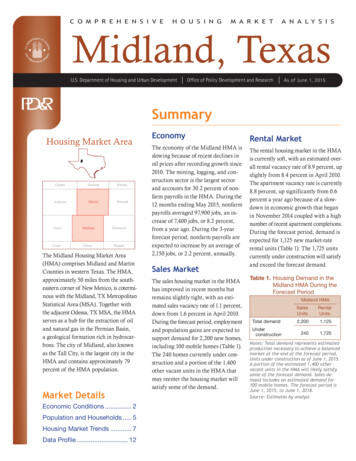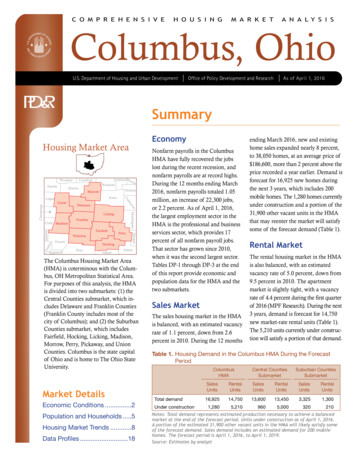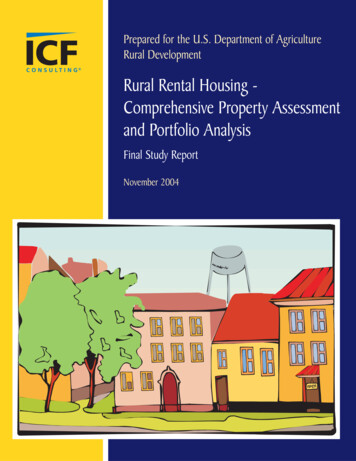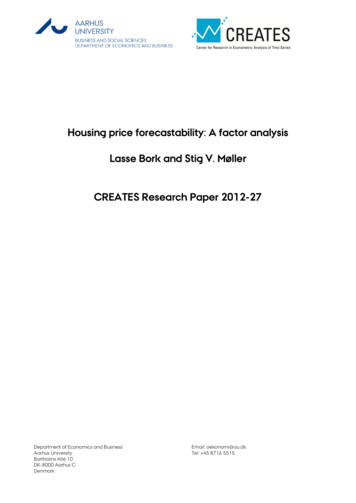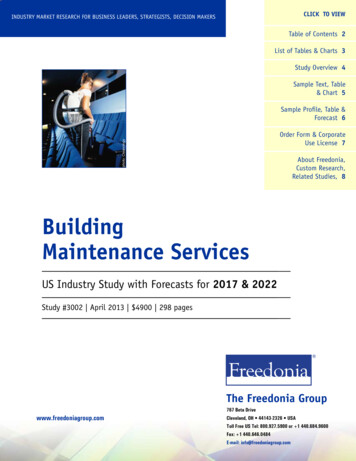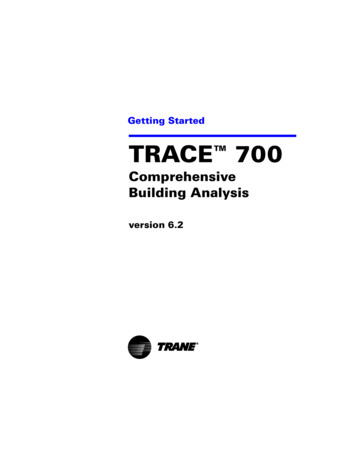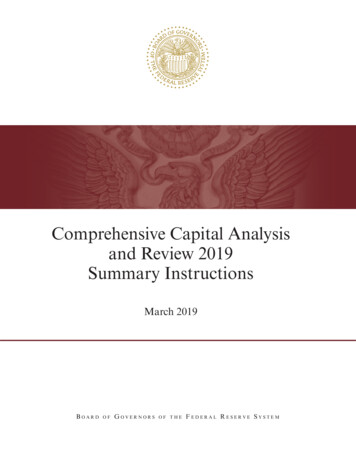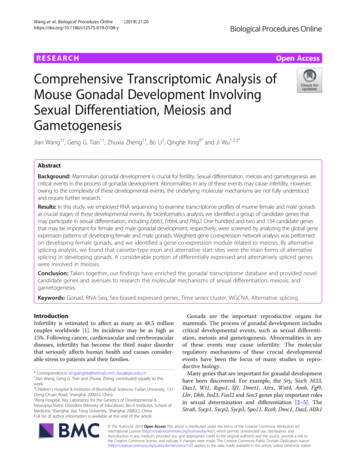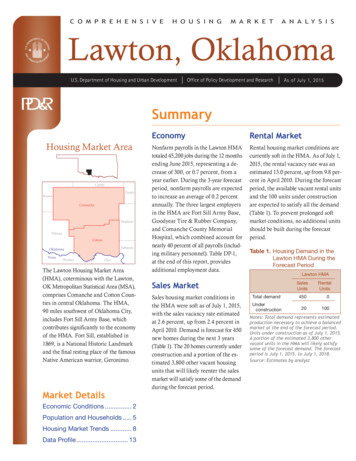
Transcription
C O M P R E H E N S I V EH O U S I N GM A R K E TA N A L Y S I SLawton, OklahomaU.S. Department of Housing and Urban DevelopmentOffice of Policy Development and ResearchAs of July 1, 2015SummaryHousing Market ffersonOklahomaTexasWichitaClayThe Lawton Housing Market Area(HMA), coterminous with the Lawton,OK Metropolitan Statistical Area (MSA),comprises Comanche and Cotton Coun ties in central Oklahoma. The HMA,90 miles southwest of Oklahoma City,includes Fort Sill Army Base, whichcontributes significantly to the economyof the HMA. Fort Sill, established in1869, is a National Historic Landmarkand the final resting place of the famousNative American warrior, Geronimo.Market DetailsEconomic Conditions. 2Population and Households. 5Housing Market Trends. 8Data Profile. 13EconomyRental MarketNonfarm payrolls in the Lawton HMAtotaled 45,200 jobs during the 12 monthsending June 2015, representing a de crease of 300, or 0.7 percent, from ayear earlier. During the 3-year forecastperiod, nonfarm payrolls are expectedto increase an average of 0.2 percentannually. The three largest employersin the HMA are Fort Sill Army Base,Goodyear Tire & Rubber Company,and Comanche County MemorialHospital, which combined account fornearly 40 percent of all payrolls (includ ing military personnel). Table DP-1,at the end of this report, providesadditional employment data.Rental housing market conditions arecurrently soft in the HMA. As of July 1,2015, the rental vacancy rate was anestimated 13.0 percent, up from 9.8 per cent in April 2010. During the forecastperiod, the available vacant rental unitsand the 100 units under constructionare expected to satisfy all the demand(Table 1). To prevent prolonged softmarket conditions, no additional unitsshould be built during the forecastperiod.Table 1. Housing Demand in theLawton HMA During theForecast PeriodLawton HMASalesUnitsSales MarketSales housing market conditions inthe HMA were soft as of July 1, 2015,with the sales vacancy rate estimatedat 2.6 percent, up from 2.4 percent inApril 2010. Demand is forecast for 450new homes during the next 3 years(Table 1). The 20 homes currently underconstruction and a portion of the es timated 3,800 other vacant housingunits that will likely reenter the salesmarket will satisfy some of the demandduring the forecast period.RentalUnitsTotal demand4500Underconstruction20100Notes: Total demand represents estimatedproduction necessary to achieve a balancedmarket at the end of the forecast period.Units under construction as of July 1, 2015.A portion of the estimated 3,800 othervacant units in the HMA will likely satisfysome of the forecast demand. The forecastperiod is July 1, 2015, to July 1, 2018.Source: Estimates by analyst
2Economic ConditionsL a w t o n , O K C O M P R E H E N S I V E H O U S I N G M A R K E T A N A LY S I SThe Lawton HMA economy issignificantly affected by thegovernment sector, which included15,300 jobs (excluding military personnel) during the 12 months endingJune 2015, or more than one-thirdof all nonfarm payrolls in the HMA(Figure 1). The HMA is home to FortSill Army Base, headquarters of theU.S. Army Field Artillery and AirDefense Artillery Fires Center of Ex cellence. Fort Sill is by far the largestemployer in the HMA, with 6,450civilian employees and 11,100 permanent military personnel comparedwith the second largest employer, Good year Tire & Rubber Company, whichemployees 2,400 workers (Table 2). Inaddition, approximately 37,000 militarypersonnel complete basic training andadvanced artillery training annuallyFigure 1. Current Nonfarm Payroll Jobs in the Lawton HMA, by SectorMining, logging, & construction 3.6%Manufacturing 7.8%Government 33.9%Wholesale & retail trade 13.9%Transportation & utilities 3.1%Information 1.1%Financial activities 4.9%Other services 2.4%Leisure & hospitality 10.8%Professional & business services 8.6%Education & health services 9.8%Note: Based on 12-month averages through June 2015; excludes military jobs.Source: U.S. Bureau of Labor StatisticsTable 2. Major Employers in the Lawton HMAName of EmployerFort Sill Army BaseGoodyear Tire & Rubber CompanyComanche County Memorial HospitalComanche Nation of OklahomaWal-Mart Stores, Inc.Serco, Inc.Cameron UniversitySwanson Services, Inc.GEO Group, Inc.Bar-S Foods–A Sigma CompanyNonfarm Payroll SectorNumber ofEmployeesGovernmentManufacturingEducation & health servicesGovernmentWholesale & retail tradeProfessional & business servicesGovernmentLeisure & hospitalityProfessional & business 860460450350Notes: Includes 11,000 permanent military personnel jobs at Fort Sill, which are notincluded in the nonfarm payroll jobs data. Excludes local school districts.Sources: Local chambers of commerce and employersat Fort Sill, and a combined 53,500military family members and retireesreside in the HMA. Fort Sill had alocal economic impact of 1.75 billionand accounted for 40 percent of thegross domestic product of the HMAduring 2014 (U.S. Department of De fense). During 2011 (the most recentdata available), Fort Sill supported anadditional 19,500 indirect jobs (Stateof Oklahoma). The HMA is also hometo the Comanche Nation of Oklahoma,which employs 1,500 workers in thelocal (tribal) government subsector atits headquarters facility, five casinos,and at Comanche Nation College.Cameron University is the seventhlargest employer in the HMA, with860 state government workers. Enroll ment at Cameron University consistsof 4,500 full-time students, including3,000 students whose original residenceswere outside the HMA (CameronUniversity Fact Book 2015). CameronUniversity has an economic impacton the HMA of about 158 millionannually (Oklahoma State Chamber).The second largest job sector is thewholesale and retail trade sector, with6,300 jobs during the 12 months endingJune 2015. The retail trade subsectoraccounted for 5,700 jobs, or about 90percent of the wholesale and retailtrade sector. Wal-Mart Stores, Inc., isthe fifth largest employer in the HMA,with 1,100 employees. The leisure andhospitality sector is the third largestjob sector, with 4,900 jobs. Severalmuseums, including the U.S. ArmyField Artillery Museum and the Coman che National Museum and CulturalCenter, and the Wichita MountainsWildlife Refuge draw visitors to theHMA. The tourism industry had aneconomic impact of 230.91 millionin 2014 on the HMA (Lawton-FortSill Chamber of Commerce).
L a w t o n , O K C O M P R E H E N S I V E H O U S I N G M A R K E T A N A LY S I S3Economic Conditions ContinuedThe Lawton HMA economy expandedthroughout most of the 2000s, with jobgrowth occurring every year except in2001. After declining by 800 jobs, or2.0 percent, in 2001, payrolls increasedby an average of 950 jobs, or 2.4 per cent, annually during 2002 and 2003,to 41,200. Contributing to job growthduring this period were gains in thelocal government subsector, which in creased by an average of 230 jobs, or3.2 percent, annually to 7,800. Gainsin the local government subsector werepartly because of increased hiring bythe Comanche Nation of Oklahomatribe with the opening of ComancheNation College in 2002, resulting in100 new jobs. Job growth continuedduring the 2004-through-2007 period,with nonfarm payrolls increasing byan average of 750, or 1.8 percent, an nually to 44,200. The governmentsector accounted for 63 percent of thenet job growth during this period, in creasing by an average of 480 jobs, or3.6 percent, annually to 14,500. TheComanche Nation of Oklahoma con tributed to gains in the governmentsector with the openings of ComancheNational Museum and Cultural Centerand Comanche Nation Casino in 2007,resulting in nearly 600 new jobs.The HMA economy continued to ex pand from 2008 through 2010, withnonfarm payrolls increasing by anaverage 670, or 1.5 percent, annuallyto 46,200. The economic expansionof the HMA during this period wasin contrast to a national decline inpayrolls of an average of 1.9 percentannually. Contributing to job growthin the HMA during this period wasan increase in the government sectorby an average of 570 jobs, or 3.8 per cent, annually, to 16,200. Job gainsin the government sector stemmedfrom the implementation of the 2005Base Closure and Realignment Commission (BRAC) recommendations,which included the relocation of theAir Defense Artillery headquarters,the Air Defense Artillery School, andthe 31st Air Defense Artillery Brigadefrom Fort Bliss Army Base in El Paso,Texas, to Fort Sill. As a result of BRACrecommendations, Fort Sill employmentincreased by approximately 1,000 mil itary personnel and 2,700 civilian employees from 2007 through 2010 (U.S.Department of Defense estimates, asof October 1). Construction activitiesassociated with BRAC recommendations totaled more than 450 million(U.S. Government AccountabilityOffice) and contributed to the mining,logging, and construction sector in creasing from 2008 through 2010 byan average of 130 jobs, or 8.2 percent,annually to 1,900 jobs. The influx ofmilitary personnel and contractorscontributed to an increase in the leisureand hospitality sector, which gainedan average of 200 jobs, or 4.3 percent,to 5,100. Hotel receipts in the city ofLawton increased by an average of 3.04 million, or 15.4 percent, annuallyto 26.06 million from 2007 through2010 (Lawton-Fort Sill EconomicDevelopment Corporation). Althougheconomic conditions improved in theHMA during this period, the manufac turing sector declined by an averageof 65 jobs, or 1.8 percent, to 3,600because of widespread layoffs. Joblosses in this sector were partly offsetby 100 new jobs resulting from theopening of BAE Systems, Inc., in thetown of Elgin, about 17 miles northof the city of Lawton. The BAE Systems facility in Elgin manufacturesequipment for the U.S. Army.The economy of the HMA declinedfrom 2011 through 2013, losing anaverage of 200 jobs, or 0.5 percent,
Economic Conditions ContinuedL a w t o n , O K C O M P R E H E N S I V E H O U S I N G M A R K E T A N A LY S I S4annually to 45,500. This decline wasprimarily the result of waning em ployment associated with the imple mentation of BRAC when numerousBRAC-related activities were completed.Job losses were widespread amongseveral sectors but were greatest in thegovernment sector, which declined byan average of 300, or 1.7 percent, annually to 15,400 jobs. The decline inpayrolls was partly offset by increases inthe professional and business servicesand the education and health servicesjob sectors, which each increased by130 jobs, or 3.8 and 3.1 percent, annually, to 3,800 and 4,600, respectively.Figure 2 shows the percentage changein nonfarm employment by job sectorsince 2000.Figure 2. Sector Growth in the Lawton HMA, Percentage Change, 2000 to CurrentTotal nonfarm payroll jobsGoods-producing sectorsMining, logging, & constructionManufacturingService-providing sectorsWholesale & retail tradeTransportation & utilitiesInformationFinancial activitiesProfessional & business servicesEducation & health servicesLeisure & hospitalityOther servicesGovernment– 50– 40– 30– 20– 10010203040Notes: Current is based on 12-month averages through June 2015. Excludes military jobs.Source: U.S. Bureau of Labor StatisticsTable 3. 12-Month Average Nonfarm Payroll Jobs in the Lawton HMA,by Sector12 Months EndingTotal nonfarm payroll jobsGoods-producing sectorsMining, logging, & constructionManufacturingService-providing sectorsWholesale & retail tradeTransportation & utilitiesInformationFinancial activitiesProfessional & business servicesEducation & health servicesLeisure & hospitalityOther servicesGovernmentJune 2014June 004,4004,9001,10015,300– 300– 100– 100– 100– 20010000– 100200– 100– 1000– 100– 0.7– 1.9– 5.9– 2.8– 0.51.60.00.0– 4.35.4– 2.2– 2.00.0– 0.6Notes: Numbers may not add to totals because of rounding. Based on 12-monthaverages through June 2014 and June 2015. Excludes military jobs.Source: U.S. Bureau of Labor StatisticsDuring the 12 months ending June2015, nonfarm payrolls in the HMAtotaled 45,200, representing a decreaseof 300 jobs, or 0.7 percent, com paredwith employment a year earlier(Table 3). Job declines were wide spread among six sectors, each ofwhich recorded decreases of 100 jobs.Only two job sectors—the professionaland business services and the whole sale and retail trade sectors—increased,by 200 and 100 jobs, or 5.4 and 1.6 per cent, to 3,900 and 6,300, respectively.Contributing to gains in the professional and business services sectorwas additional hiring by Serco, Inc.,resulting in 475 new jobs. Serco, the
5Economic Conditions ContinuedThe average unemployment rate inthe HMA was 4.4 percent during the12 months ending June 2015, downfrom 5.4 percent a year earlier. From2000 through 2007, the average unem ployment rate was 4.1 percent. In creased hiring during 2008 resulted ina decrease in the unemployment rateto 3.7 percent before increases duringthe next 2 years to a rate of 5.8 percentduring 2010. This increase occurred60,00010.055,0008.06.050,0004.0Labor force14132012202010112009Resident 12.040,0000045,000Unemployment rateFigure 3. T rends in Labor Force, Resident Employment, and Unemploy ment Rate in the Lawton HMA, 2000 Through 2014Labor force andresident employmentL a w t o n , O K C O M P R E H E N S I V E H O U S I N G M A R K E T A N A LY S I Ssixth largest employer in the HMAwith 975 employees, provides contractservices for the federal government. Theopening of new stores by Wal-MartStores and CVS Health Corporation inearly 2015 resulted in a combined 150new jobs and contributed to gains inthe wholesale and retail trade job sector.Unemployment ratebecause gains in the labor force, whichaveraged 2,350, or 4.6 percent, annually outpaced an increase in residentemployment, which increased by anaverage of 1,700, or 3.5 percent, annu ally. Declines in resident employmentresulted in the unemployment rate in creasing to 6.0 percent by 2012 beforedecreasing to 5.8 percent in 2013. Fig ure 3 shows trends in the labor force,resident employment, and the unem ployment rate from 2000 through 2014.During the 3-year forecast period, non farm payrolls are expected to increaseby an average of 100 jobs, or 0.2 percent, annually. Job gains are expectedin the manufacturing sector because ofan expansion by Silver-Line Plastics,a plastic pipe manufacturing companybased in the city of Lawton. The ex pansion, which began in June 2015,is expected to result in approximately100 new jobs during the next 5 years(Silver-Line estimates). An expansionat BAE Systems is also under way andexpected to result in an additional 100new jobs during the next 3 years inthe town of Elgin.Source: U.S. Bureau of Labor StatisticsPopulation and HouseholdsThe current population of theLawton HMA is an estimated131,200, representing an average in crease of 170, or 0.1 percent, annuallysince 2010 (U.S. Census Bureau de cennial census counts). During thisperiod, net out-migration occurred atan average of 820 residents annually,mostly because of the completion ofwork stemming from BRAC-relatedrecommendations at Fort Sill ArmyBase and consequent decrease in mil itary personnel and family membersby an average of 1,050, or 3.7 percent,annually to 25,600 from 2009 to 2014(U.S. Department of Defense estimates,as of October 1). Also contributing tonet out-migration since 2010 was adecrease in nonfarm employment atan average rate of 0.3 percent annually.The more populous county in the HMAis Comanche County, accounting for
an estimated 95 percent of the totalpopulation; Cotton County comprisesthe remaining 5 percent. The population of the city of Lawton, which in cludes Fort Sill, is an estimated 97,000,or about three-fourths of the totalpopulation of the HMA. From 2010to 2014, the population of Lawton wasunchanged (Census Bureau decennialcensus counts and population estimates,as of July 1). During the same period,the town of Elgin in Comanche Countywas the fastest growing municipalityin the HMA, increasing by an averageof 180, or 7.3 percent, to 2,900, mostlybecause of local increased employmentopportunities BAE Systems and in creased appeal to homebuyers.L a w t o n , O K C O M P R E H E N S I V E H O U S I N G M A R K E T A N A LY S I S6Population and Households ContinuedDuring the 2000s, the population ofthe HMA fluctuated significantly,reflecting changes in the number ofmilitary personnel and family membersat Fort Sill more than changes in non farm employment. From 2000 to 2003,the population decreased by an aver age of 1,275, or 1.1 percent, annuallyto 117,500 (Census Bureau decennialcensus counts and population estimates,as of July 1). During this period, netout-migration occurred at an aver age of 2,300 people annually. ByFigure 4. Population and Household Growth in the Lawton HMA,2000 to Forecast900Average annual change80070060050040030020010002000 to 20102010 to currentPopulationCurrent to forecastHouseholdsNotes: The current date is July 1, 2015. The forecast date is July 1, 2018.Sources: 2000 and 2010—2000 Census and 2010 Census; current and forecast—estimates by analystcomparison, the number of militarypersonnel and family members at FortSill decreased by an average of 1,100annually from 2000 to 2003 (U.S. De partment of Defense estimates, as ofOctober 1). Strong job growth in theHMA contributed to the populationincreasing from 2003 to 2007 by anaverage of 2,075, or 1.7 percent, annu ally to 125,800, with net in-migrationaccounting for more than one-half ofthe population growth. Also contributing to the population growth duringthis period was an average increase inthe number of military personnel andfamily members at Fort Sill of 170annually from 2003 to 2007. From2007 to 2010, the population of theHMA increased by 1,625, or 1.3 per cent, annually to 130,300, with netin-migration accounting for nearly30 percent of the population growth(Census Bureau decennial censuscounts and population estimates, asof July 1). In addition to strong jobgrowth, an influx of 2,150 militarypersonnel and families to Fort Sill asa result of BRAC-related activitiescontributed to population gains duringthis period. Students were also drawnto the HMA during this period to attendCameron University, where enrollmentincreased by an average of 180 students,or 4 percent, annually to 4,775 studentsfrom 2007 through 2010 (CameronUniversity Department of InstitutionalResearch, Assessment & Accountabil ity). Employment opportunities andseveral new single-family home devel opments also drew residents to Elgin,where the population increased by anaverage of 250, or 15 percent, annuallyto 2,150 from 2007 to 2010 (CensusBureau decennial census counts andpopulation estimates, as of July 1).Figure 4 shows population and house hold growth in the HMA from 2000to the forecast date.
During the 3-year forecast period, thepopulation of the HMA is expectedto increase by an average of 770, or0.6 percent, annually to 133,500, en tirely because of net natural increase(Figure 5). The recent trend in net outmigration is expected to reverse bythe second year of the forecast period,partly because of the influx of an addi tional 220 military personnel and theirrespective family members to Fort Sillas a result of the Budget Control Actof 2011.The number of households in theHMA is currently an estimated 48,000,Figure 5. Components of Population Change in the Lawton HMA,2000 to ForecastAverage annual changeL a w t o n , O K C O M P R E H E N S I V E H O U S I N G M A R K E T A N A LY S I S7Population and Households Continued1,5001,0005000– 500– 1,0002000 to 20102010 to currentNet natural changeCurrent to forecastNet migrationNotes: The current date is July 1, 2015. The
the Comanche Nation of Oklahoma tribe with the opening of Comanche Nation College in 2002, resulting in 100 new jobs. Job growth continued during the 2004-through-2007 period, with nonfarm payrolls increasing by an average of 750, or 1.8 percent, an- nually to 44,2

